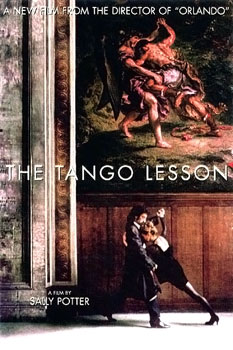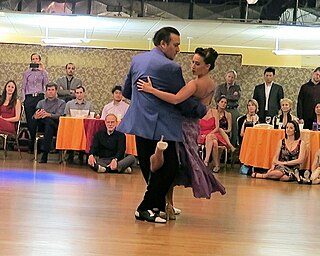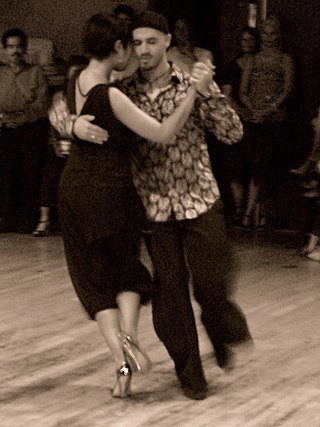
Gustavo Naveira (born 12 August 1960) is an Argentine tango dancer and teacher who contributed to the detailed analysis of the movements of dancing to Argentine tango.

Gustavo Naveira (born 12 August 1960) is an Argentine tango dancer and teacher who contributed to the detailed analysis of the movements of dancing to Argentine tango.
He was born in Comodoro Rivadavia, province of Chubut. His family moves to Buenos Aires when he was 1 year old. [1] He played the guitar from age 7 to 20 and studied it at the conservatory for 3 years. He has been dancing since the age of 20. His parents met while dancing milonga. His first professors of tango were Dinzels. [2]
My first steps with dancing occurred unexpectedly when I studied economy in the University of Buenos Aires where there was a course which I attended. There I came to know of my affinity with dancing. Later I studied folk music dancing and enrolled in short courses of classical, modern and Spanish dances. But always it was rather out of curiosity than for a professional interest. [1]
The first teacher I had was Rodolfo Dinzel. But I learnt things from several milongueros in a not much organized way. An instructor that gave me a lot was Pepito Avellaneda but I cannot leave unmentioned Antonio Todaro and Gerardo Portalea. [1]
He appeared in the tango lesson movie with Sally Potter in 1997 and he formed a group with Fabian Salas and Pablo Veron during preparation for that movie. Later, together with Salas he would begin the Cosmotango organization in which he took part for just a couple of years.
He has been dancing with Giselle Anne since approximately 1995. They met in Spain, at Sitges dancing together in a show. [1]
They are known for their intellectual approach to dance as teachers. Together they have 2 kids. Gustavo has also 2 kids, Ariadna and Federico, from previous relationship with Olga Besio.
Gustavo and Gisele Anne live in Boulder, Colorado where they have their own tango studio and teach tango seminars. They travel and teach tango abroad. From 2010 they organize in Boulder, Colorado an Argentine Tango Festival: BTF (Boulder Tango Festival), around the months of September/October each year.
In 2009 he published programmatic essay New Tango [3] in which he states: “There is great confusion on the question of the way of dancing the tango: call it technique, form, or style. The term tango nuevo, is used to refer to a style of dancing, which is an error. In reality, tango nuevo is everything that has happened with the tango since the 1980s. It is not a question of a style... The words tango nuevo express what is happening with tango dancing in general; namely that it is evolving. Tango nuevo is not one more style; it is simply that tango dancing is growing, improving, developing, enriching itself, and in that sense we are moving toward a new dimension in tango dancing...There has been much recent discussion, in the community of tango dancers, on the problem of the embrace, dividing the dance into open or closed style, which is also a matter of great confusion. Open embrace or closed embrace, dancing with space or dancing close, these are all outmoded terms. This is an old way of thinking, resulting from the lack of technical knowledge in past eras. This simple and clumsy division between open and closed is often used by those who try to deny the evolution of the dance, to disguise their own lack of knowledge. Today it is perfectly clear that the distances in the dance have a much greater complexity than a simple open or closed... We have learned, and we have developed our knowledge. The result of this is a dance of greater possibilities, and also of a much more artistic quality.”
He managed to clarify concepts about the structure of the dance. This has allowed many to understand tango dance better and teaching levels have risen considerably thanks to these concepts. He exposed the different uses of the axis and the structure of the turn ('giro'). He managed to translate this structure to the whole dance simplifying it all in 'cruce adelante', 'apertura' and 'cruce atrás'. He also managed to clarify the different ways of understanding and explaining changes of directions and he also transmitted the interpretation of rhythmical patterns specially the so-called 'cincopations'.
The critics in Bs. As. said: "…You could say that three stylistic tendencies contend for supremacy: Urquiza’s style, Almagro’s style and Naveira’s style …" (Clarín 8/8/99, Buenos Aires Argentina).
He was one of the main influences of Chicho Frumboli's beginnings as a tango dancer.

Astor Pantaleón Piazzolla was an Argentine tango composer, bandoneon player, and arranger. His works revolutionized the traditional tango into a new style termed nuevo tango, incorporating elements from jazz and classical music. A virtuoso bandoneonist, he regularly performed his own compositions with a variety of ensembles. In 1992, American music critic Stephen Holden described Piazzolla as "the world's foremost composer of Tango music".

The music of Argentina includes a variety of traditional, classical, and popular genres. According to the Harvard Dictionary of Music, Argentina also "has one of the richest art music traditions and perhaps the most active contemporary musical life.

Tango is a partner dance and social dance that originated in the 1880s along the Río de la Plata, the natural border between Argentina and Uruguay. The tango was born in the impoverished port areas of these countries from a combination of Argentine Milonga, Spanish-Cuban Habanera, and Uruguayan Candombe celebrations. It was frequently practiced in the brothels and bars of ports, where business owners employed bands to entertain their patrons. It then spread to the rest of the world. Many variations of this dance currently exist around the world.

The Tango Lesson is a 1997 drama film written and directed by Sally Potter. It is a semi-autobiographical film starring Potter and Pablo Verón, about Argentinian Tango.

Tango is a style of music in 2
4 or 4
4 time that originated among European and African immigrant populations of Argentina and Uruguay. It is traditionally played on a solo guitar, guitar duo, or an ensemble, known as the orquesta típica, which includes at least two violins, flute, piano, double bass, and at least two bandoneóns. Sometimes guitars and a clarinet join the ensemble. Tango may be purely instrumental or may include a vocalist. Tango music and dance have become popular throughout the world.

Candombe is a style of music and dance that originated in Uruguay among the descendants of liberated African slaves. In 2009, the United Nations Educational, Scientific and Cultural Organization (UNESCO) inscribed candombe in its Representative List of the Intangible Cultural Heritage of Humanity.
Nuevo tango is both a form of music in which new elements are incorporated into traditional tango music, and an evolution of tango dance that began to develop in the 1980s.

Argentine tango is a musical genre and accompanying social dance originating at the end of the 19th century in the suburbs of Buenos Aires. It typically has a 2
4 or 4
4 rhythmic time signature, and two or three parts repeating in patterns such as ABAB or ABCAC. Its lyrics are marked by nostalgia, sadness, and laments for lost love. The typical orchestra has several melodic instruments and is given a distinctive air by the bandoneon. It has continued to grow in popularity and spread internationally, adding modern elements without replacing the older ones. Among its leading figures are the singer and songwriter Carlos Gardel and composers/performers Francisco Canaro, Juan D'Arienzo, Carlos Di Sarli, Osvaldo Pugliese, Elvira Santamaría, and Ástor Piazzolla.
María de Buenos Aires is a tango opera with music by Ástor Piazzolla and libretto by Horacio Ferrer that premiered at the Sala Planeta in Buenos Aires on 8 May 1968.

Mariano Chicho Frúmboli is an Argentinian tango dancer. He is regarded as one of the founders of tango nuevo, and he is best known for his musicality and creativity while improvising.

Norberto Esbrez was an Argentine tango dancer, choreographer and teacher.

Homer Ladas contemporary US argentine tango dancer and teacher.
José Bragato was an Italian-born Argentine cellist, composer, conductor, arranger and musical archivist who, in his early career, was principal cellist in the Colón Theatre orchestra in Buenos Aires, Argentina. Apart from his involvement in classical music he also performed for many years in a number of Ástor Piazzolla's Nuevo tango ensembles where his cello solos, which had never before featured in tango, put him in the vanguard of Nuevo tango from its birth in the 1950s. Since then he has done numerous and varied arrangements of Piazzolla's compositions.
Queer Tango is to dance Argentine tango without regard to the traditional heteronormative roles of the dancers, and often to exchange the leader and follower roles. Therefore, it is related to open role or same-sex tango. The queer tango movement permits not only an access to tango for the LBGTQIAA+ community, but also supports female leaders and male followers, regardless of sexual orientation.
Figures of Argentine tango are elements of Argentine tango.
Fernando Egozcue is an Argentinian guitarist and composer.

Milonguero is a style of close-embrace tango dancing, the name coined by Susana Miller and Oscar "Cacho" Dante from the Argentine word "milonguero". Milonguero is a term for a skillful and respectful tango dancer who holds a reverence for the type of traditional social tango that is danced at milongas in Buenos Aires, Argentina. The two uses of the term do not coincide: many dancers who are considered to be milongueros do not dance milonguero-style tango.

A milonguero is a person who spends time dancing social tango. The word comes from the term milonga referring to a tango dance event.

Alberto Bernardino Paz was an Argentine tango historian, teacher, and dancer. Alberto taught the traditional, social tango of the Buenos Aires salons, together with its codes and culture, to North Americans and Europeans.
Roberto Herrera is an Argentinian dancer, choreographer and dance teacher, known for the Tango.